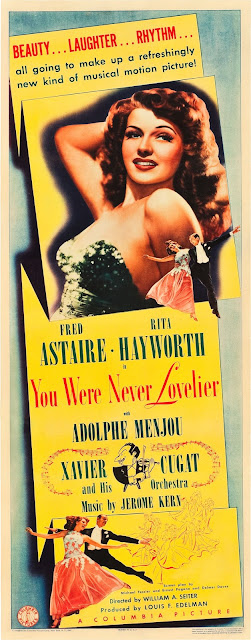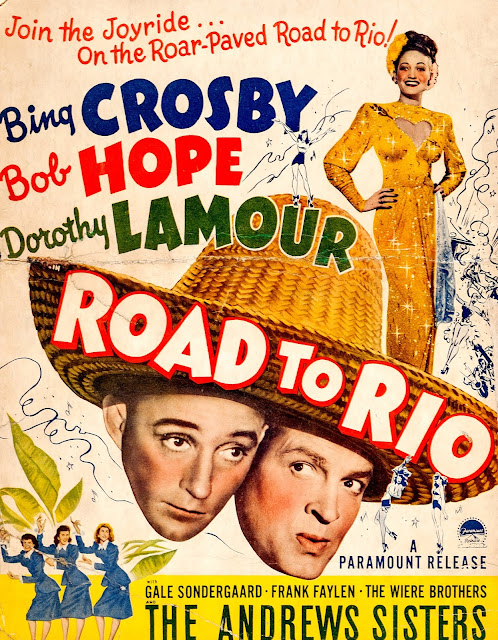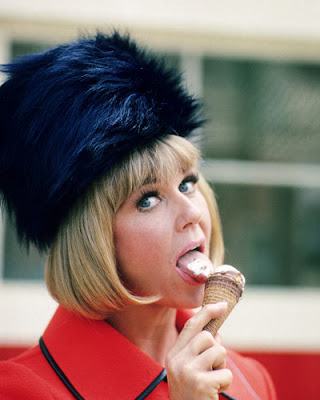A Glance at Robert Riskin's Magic Town (1947)
When you think of Frank Capra, you think of humanity and what we're capable of -- idealism, love, cruelty, greed, kindness, hope... I've always ascribed to the belief that to watch a Capra film is to study mankind. Yet, lately I've begun to wonder just how much of the qualities we label as Capra's were actually his. You see, many of the filmmaker's greatest and most iconic films were penned by Robert Riskin, a prolific, stunningly good screenwriter. The men worked beautifully together... until they didn't. But that's a story for a different time. What I'm interested in is how do you delineate what came from Capra and what came from Riskin?
Obviously, this is a huge, research-heavy question that I couldn't possibly undertake at the moment. Instead, let's (barely) scratch the surface of this idea by looking at Magic Town, a 1947 film written and produced by Riskin that everyone has defined as Capra-esque despite the director not being involved at all.
Inspired by the Middletown studies, which took place in an Indiana town near mine called Muncie, Magic Town focuses on the then-relatively-new science of public opinion polling. Jimmy Stewart is Lawrence "Rip" Smith, a pollster whose business has just gone under. When Rip realizes that a survey conducted in the small town of Grandview by his former army mate, Hoopendecker (a bespectacled Kent Smith), exactly matches a national survey, he discovers that Grandview's demographics are identical to the country as a whole. Having found the "mathematical miracle" he's been waiting for, Rip convinces one of his clients that he can deliver a survey on progressive education before a competitor can.
With right-hand man Ike (Ned Sparks) and statistician Mr. Twiddle (Donald Meek) in tow, Rip arrives in Grandview (or rather Chico, CA), posing as an insurance salesman so the townspeople's opinions won't be influenced by his job as a pollster. Almost immediately, though, a wrench is thrown into their plan by local newspaper editor Mary Peterman (Jane Wyman). For years, Mary has been advocating for a new civic center, a cause that was near and dear to her late father's heart. When Rip overhears Mary pleading with the town council to allow this major change to happen, he becomes worried about how this will affect his polling and undercuts Mary by making an impassioned speech of his own.
Understandably furious, she publishes an article questioning this stranger's intentions and tries to keep him at a distance. Over time, though, Rip endears himself to Mary as he becomes the high school's new basketball coach and gets to know the townspeople. Of course, the more involved Rip becomes, the guiltier he feels. Things get worse when Mary finds out the truth and plasters it on the newspaper's front page, ignoring Rip's insistence that doing so will damage her beloved Grandview. He is soon proven right as news about the perfect town spreads. Everything that was sweet and innocent about Grandview is crushed as the townspeople start selling their opinions, a ridiculously over-the-top civic center is planned, and flocks of people move there. Can Mary and Rip forgive each other and return Grandview back to what it once was?
In 1946, Riskin and his brother Everett formed Robert Riskin Productions. Magic Town was its first project, with the story evolving from Riskin's time as chief of the overseas motion picture bureau of the Office of War Information. Filmmaker William Wellman worked on some aspects of the script with Riskin and, despite some suggestions to the contrary, was attached to direct early on. (Curiously enough, Capra would later claim that he worked on the script with Riskin and was replaced as director by Wellman, but this doesn't seem to be true.) Incredibly, the first cut of the picture that was put into previews ran three hours. After audiences complained that the story felt "disconnected," Riskin started production back up for two weeks for retakes and additional scenes.
The result is a pleasant, underrated, 103-minute gem. Capra's favorite leading man Jimmy Stewart is once again portraying a Mr. Smith, but Rip is much less of a wide-eyed optimist than Jeff from Mr. Smith Goes to Washington. He has no qualms in exploiting Grandview for his gain initially, and his last-ditch effort to help the town is slightly sneaky, but both characters are similar in their overall decency and likability. Riskin wrote the part for Stewart and damned if it doesn't fit him like a well-worn glove. Throughout the film, I couldn't take my eyes off of him. This shouldn't have surprised me since I've been in love with the guy ever since I first saw him, but Magic Town captures something about Stewart that is especially potent.
Perhaps it is because it embraces his quirkiness. There are many delightful moments sprinkled into the movie that give it an oddball charm. For example, after looking around his now-empty office space, Rip spontaneously grabs Ike and they waltz around the room. Later, Stewart does a spot-on impression of Sparks that is guaranteed to make you snort. In another scene, Mary and Rip are flirting with each other in a classroom and the conversation turns to poetry. Mary begins reciting Longfellow's "Hiawatha," but Rip likes Tennyson's "Charge of the Light Brigade" better and tries to drown her out with his own recitation. As the two loudly talk over one another, the school's janitor stumbles upon them and, shrugging his shoulders, starts performing lines from Romeo and Juliet. None of it makes sense, and yet it completely fits.
Another aspect of the film that highlights Stewart is Joseph F. Biroc's cinematography. Typically, classic Hollywood likes to emphasize the actresses with plenty of dreamy lighting; while Magic Town does make Jane Wyman look beautiful, it is clearly Stewart whom the camera loves. (The gorgeous print that Olive Films offers just makes it more obvious, too.) Although this is a fun romantic comedy, Biroc has no problem in playing with the darkness and lightness of a scene.
Admittedly, I'm not very knowledgeable about William Wellman. I've seen about nine of his films, and yet I've never really taken note of his style, which, now that I think about it, baffles me. Especially since I couldn't help but pay attention to it during Magic Town. Wellman's compositions caught my eye over and over, in part because of their use of shadows but also because of the way he foregrounded characters to add depth to the frame. He kept repeating this shot of Wyman's eyes, too:
Although it's a striking image, I'm not sure what Wellman is trying to tell us. I have a feeling it might be connected to how smart and intuitive Mary is. She rarely misses a beat and she is constantly aware of what other characters are saying or doing.
There are also some fascinating montages, which are credited to William Hornbeck at the beginning of the film. Below are my two favorite shots:
Another motif of Wellman's is showing us a character being overwhelmed by an emptied space, signifying how alone they feel in the moment.
In that last image, Mary is at her lowest point. Rip appears and, separated by the stove fireplace, finally tells her that he loves her. Although Mary admits that she has longed to hear those words, she can't brush aside the fact that they helped ruin Grandview and decides that until they fix what they did, they can't be together, an idea that is reinforced by the seclusion of the characters in the mise-en-scene.
While Stewart and Wyman are both stellar here, I must say the rest of the cast help make this film as special as it is, too. Ann Shoemaker is wonderful as Mary's mother; Kent Smith is surprisingly good as Hoopendecker; and the whole town council is great, including Regis Toomey, Howard Freeman, and Harry Holman. I also have to single out Julia Dean for her very small role as Senator Wilton's wife. She only has one scene, but she almost steals the entire film.
Ned Sparks, one of my favorite character actors, is perfect as Ike, a role that ended his four-year absence from the screen. Sadly, another character actor that I cherish, Donald Meek, died during production. Meek's character disappears from the story, but in a rather subtle moment, the film acknowledges the absence by having Ike tell Rip, "Mr. Twiddle took the earlier train."
A box-office flop when it was released, Magic Town seems to have been practically forgotten these days, which is insane considering the talent involved. For Stewart, it was his second post-WWII film (after It's a Wonderful Life), marking a bump in the road before finding success with his next project, Call Northside 777, and his eventual collaborations with Anthony Mann and Alfred Hitchcock. For Wyman, Magic Town was like the comedic breather between her Oscar-nominated dramatic performances in The Yearling and Johnny Belinda, the latter winning her the golden statuette. For Riskin, it was an opportunity to prove he was more than Frank Capra's sidekick. It may not have succeeded at the time, but I think we can look at Magic Town now and recognize that Capra owed more to Riskin than we were ever told.
The result is a pleasant, underrated, 103-minute gem. Capra's favorite leading man Jimmy Stewart is once again portraying a Mr. Smith, but Rip is much less of a wide-eyed optimist than Jeff from Mr. Smith Goes to Washington. He has no qualms in exploiting Grandview for his gain initially, and his last-ditch effort to help the town is slightly sneaky, but both characters are similar in their overall decency and likability. Riskin wrote the part for Stewart and damned if it doesn't fit him like a well-worn glove. Throughout the film, I couldn't take my eyes off of him. This shouldn't have surprised me since I've been in love with the guy ever since I first saw him, but Magic Town captures something about Stewart that is especially potent.
Perhaps it is because it embraces his quirkiness. There are many delightful moments sprinkled into the movie that give it an oddball charm. For example, after looking around his now-empty office space, Rip spontaneously grabs Ike and they waltz around the room. Later, Stewart does a spot-on impression of Sparks that is guaranteed to make you snort. In another scene, Mary and Rip are flirting with each other in a classroom and the conversation turns to poetry. Mary begins reciting Longfellow's "Hiawatha," but Rip likes Tennyson's "Charge of the Light Brigade" better and tries to drown her out with his own recitation. As the two loudly talk over one another, the school's janitor stumbles upon them and, shrugging his shoulders, starts performing lines from Romeo and Juliet. None of it makes sense, and yet it completely fits.
Another aspect of the film that highlights Stewart is Joseph F. Biroc's cinematography. Typically, classic Hollywood likes to emphasize the actresses with plenty of dreamy lighting; while Magic Town does make Jane Wyman look beautiful, it is clearly Stewart whom the camera loves. (The gorgeous print that Olive Films offers just makes it more obvious, too.) Although this is a fun romantic comedy, Biroc has no problem in playing with the darkness and lightness of a scene.
Admittedly, I'm not very knowledgeable about William Wellman. I've seen about nine of his films, and yet I've never really taken note of his style, which, now that I think about it, baffles me. Especially since I couldn't help but pay attention to it during Magic Town. Wellman's compositions caught my eye over and over, in part because of their use of shadows but also because of the way he foregrounded characters to add depth to the frame. He kept repeating this shot of Wyman's eyes, too:
Although it's a striking image, I'm not sure what Wellman is trying to tell us. I have a feeling it might be connected to how smart and intuitive Mary is. She rarely misses a beat and she is constantly aware of what other characters are saying or doing.
There are also some fascinating montages, which are credited to William Hornbeck at the beginning of the film. Below are my two favorite shots:
Another motif of Wellman's is showing us a character being overwhelmed by an emptied space, signifying how alone they feel in the moment.
In that last image, Mary is at her lowest point. Rip appears and, separated by the stove fireplace, finally tells her that he loves her. Although Mary admits that she has longed to hear those words, she can't brush aside the fact that they helped ruin Grandview and decides that until they fix what they did, they can't be together, an idea that is reinforced by the seclusion of the characters in the mise-en-scene.
While Stewart and Wyman are both stellar here, I must say the rest of the cast help make this film as special as it is, too. Ann Shoemaker is wonderful as Mary's mother; Kent Smith is surprisingly good as Hoopendecker; and the whole town council is great, including Regis Toomey, Howard Freeman, and Harry Holman. I also have to single out Julia Dean for her very small role as Senator Wilton's wife. She only has one scene, but she almost steals the entire film.
Ned Sparks, one of my favorite character actors, is perfect as Ike, a role that ended his four-year absence from the screen. Sadly, another character actor that I cherish, Donald Meek, died during production. Meek's character disappears from the story, but in a rather subtle moment, the film acknowledges the absence by having Ike tell Rip, "Mr. Twiddle took the earlier train."
A box-office flop when it was released, Magic Town seems to have been practically forgotten these days, which is insane considering the talent involved. For Stewart, it was his second post-WWII film (after It's a Wonderful Life), marking a bump in the road before finding success with his next project, Call Northside 777, and his eventual collaborations with Anthony Mann and Alfred Hitchcock. For Wyman, Magic Town was like the comedic breather between her Oscar-nominated dramatic performances in The Yearling and Johnny Belinda, the latter winning her the golden statuette. For Riskin, it was an opportunity to prove he was more than Frank Capra's sidekick. It may not have succeeded at the time, but I think we can look at Magic Town now and recognize that Capra owed more to Riskin than we were ever told.
__________________
This is my first of two contributions to Fay Wray and Robert Riskin, The Blogathon. To read more about this fascinating couple and their contributions to Hollywood, click here!




























































































Yep. As you said, none of it makes sense, but it all fits.
ReplyDeleteWellman is difficult to pin down because his goal was to make every kind of picture, and that is just what he did. He is at his best when he is touched by the story/script and I think we can see that here.
Thanks for the insight about Wellman. I've often heard other classic movie bloggers praise him, which I'm sure he deserves, but I've just never really given him my full attention -- clearly, that's something I need to rectify!
DeleteI love the premise by which you begin bc it's true. The more one learns about Riskin's career, the more one has to wonder if a lot of "Capraesque" should not be "Riskinesque."
ReplyDeleteAlso, terrific commentary on a wonderful, if under-appreciated and watched, film. It's a head-scratcher why that is.
Thank you for this entry for the blogathon. Entertaining read!
Aurora
Thanks so much, Aurora! I felt charmed by this film when I first saw it two years ago, and I was glad to see upon rewatching it for this post that it was still just as wonderful as I remembered.
DeleteYou raise an interesting question re: how much was Riskin and how much was Capra in their collaborations. I think Magic Town is a bit of an eye-opener in that respect.
ReplyDeleteA terrific, insightful review as always, Michaela. I need to see this one again soon! :)
Thanks, Ruth! This question of Riskin versus Capra had never occurred to me until recently, and now I'm just fascinated by it. Definitely something I'll be keeping in mind whenever I watch their work in the future.
Delete